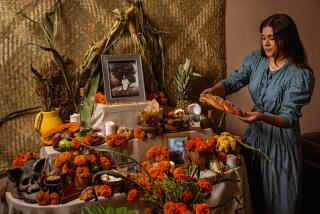The Guelaguetza--Oaxaca’s Vibrant Celebration
- Share via
OAXACA, Mexico — Beneath the spreading foliage of an enormous tree at Tule, a blind piper plays his haunting air. His grandson (perhaps 10) beats time on a snare drum. When tourists drop coins or bills into the piper’s open sombrero the boy alters his beat, and the old man, hearing it, reaches out with one gnarled hand to sweep up the dinero.
Tourists swarm around this massive tree, a cypress more than 2,000 years old, perhaps the oldest living thing in Mexico. It was a sapling when the ancient Zapotecs ruled this land from their mountaintop holy city at Monte Alban centuries before Christ. It bloomed tall when the artful Mixtecs carved from native stone the elaborate decorations of the walls of their buildings at nearby Mitla 1,200 years ago.
This tree saw the arrival of the militant Aztecs, and, in 1523, the conquerors (as they are known in Mexico), the conquistadors of Cortez. As for Cortez, he loved this fertile valley and wanted it for his fiefdom, taking the title of Marquis del Valle de Oaxaca; he may have napped under this ancient tree.
The Busy Season
Tourists are everywhere in Oaxaca, for this is the season of the Guelaguetza. Hotels are full, restaurants crowded, the markets mobbed with bargainers for Oaxaca’s famed pottery and woven goods. One waits eternally for a table at the sidewalk cafes that ring the zocala (central square); it is said that from those tables you can see all of Oaxaca parade by on the wide boulevards around the zocala (closed to vehicular traffic).
Tickets to the Guelaguetza, unless you’ve made previous arrangements, are impossible to come by.
These Indian dances performed by brilliantly costumed villagers from the seven tribal areas of the state of Oaxaca are reportedly as old as the tree at Tule; the tradition of the Guelaguetza goes back to the era of the Zapotecs. Guelaguetza in the Zapotec language means an offering, and tradition has it that through the centuries the Indian villagers each year have brought as offerings their dances, their elaborate costumes with feathery headdresses and brocaded and beaded dresses, plus, most importantly, their handicrafts and artistry and the fruits of their fields.
Mondays on the Hill
For vacationers planning trips for summer ‘87, the Guelaguetza is held on the last two Mondays in July in an open amphitheater on Cerro del Fortin de Zaragoza, the hill that overlooks the city of Oaxaca; the ceremony is also known as Lunes del Cerro, Mondays on the Hill.
The amphitheater with its large, circular stage has a reported capacity of 15,000, but for the Guelaguetza nearly 20,000 jam their way in, clogging the aisles and passages and clinging to the mountainside above the stadium.
The dances begin at 10 a.m., and on these sweltering July mornings vendors do a land-office business in paper hats, gaily colored paper umbrellas, sombreros and cold drinks.
Though a brass band is loudly present, the electronic age has infected even the Guelaguetza; most of the 17 troupes that appeared the day I was there danced to recorded music.
Dancers Bearing Gifts
Each program opened with a processional, some involving massive, grotesque puppets with dancers inside; each included peasants bearing on their heads or in huge pots strapped to their backs the fruits and produce of their region.
These offerings are piled on the apron of the stage before the dances begin, and at the conclusion of each dance, in what may well be a high point for many of the thousands gathered here, they are tossed to the crowd.
It’s one thing to have small bags of coffee thrown at you or even straw hats sailed like Frisbees over the crowd, but quite another to be bombarded with pineapples weighing five or six pounds each, or avocados hard as baseballs.
The crowd loves it, howling with glee at catching a pineapple; some bring large bolsas (plastic bags) in hopes of collecting loot. Special gifts are presented to dignitaries in their boxes, including, the day I was there, the ambassador from Japan (Mexico has just received a billion-dollar loan from Japan).
But the dances are what you are there for, and they are exquisite, an explosion of color and movement on that big stage, rich and varied against the blue summer skies.
The theme of each dance is announced in the native language of the village, usually a variation of Zapotec or Mixtec, followed by a translation in Spanish, a second language in Oaxaca’s Indian villages. Mostly, these are mating dances, flirtations and pursuit--the senorita with a flower between her teeth ends the chase when her man wins the flower.
Matadors in Pajamas
One of the most delightful was from the mountain village of Macuiltianguis. The men were matadors (in white pajamas), the girls the bulls. The men fluttered red handkerchiefs to make the bulls charge, but the bulls invariably butted the men over, in some cases butted them clear off the stage into the crowd: bullfights the bulls won.
Another troupe from Tuxtepec, with pineapples on their shoulders and costumes of so ancient a design that they are shown in museums, offered precision dancing that would make a Rockette green with envy. For four hours I sat and marveled at the endlessly varied creative beauty, each troupe from each village individual.
Oaxaca, on a mile-high plateau about 350 miles south of Mexico City on the Pan American Highway to Guatamala and Panama, has become a major tourist center, mostly for well-heeled vacationing Mexicans from smog-ridden Mexico City and from Guadalajara, Monterrey and other metropolitan areas. There were also Europeans when I was there, mostly French, and fewer Americans than I’d expected.
Archeological Sites
The primary attractions, of course, are the great archeological sites. The ruins of Monte Alban are just outside the city, though several thousand feet above it. One can wander through the vast geometric pattern of the city, climb its pyramids and temples, explore the ball court and what may have been an observatory, see the grossly misshapen figures of “The Dancers” carved in stone. Once thought to portray dancers, these huge stone blocks are now believed to be illustrations of malformations and diseases, a text used in an ancient medical school.
When the Zapotecs of Monte Alban unaccountably disappeared about a thousand years ago, the Mixtecs, a tribe of brilliant artisans whose city of Mitla was an artistic triumph, turned Monte Alban into a vast burial ground. From one of the tombs excavated 40 years ago was recovered a magnificent collection of Mixtec art and jewelry. It’s the greatest such discovery ever made in the Western World, rivaling Tutankhamen’s treasure.
Museum Display
One can gape at this treasure in Oaxaca’s regional museum where more than 500 works of art from the tomb in gold and jade, alabaster, pearl, turquoise and onyx, pottery, religious figures, masks and the like are on display. More than 160 tombs at Monte Alban have been explored, but only this one, Tomb Seven, yielded such treasure.
Oaxaca may be the most immaculate city in Mexico, perhaps on this continent. Everywhere are signs and bumper stickers proclaiming: “La Ciudad Limpia Esta la Ciudad Bonita,” the Clean City Is the Beautiful City. The populace has apparently taken the message to heart; the city shines like a new peso.
Nowhere is there better evidence than on the broad boulevard known as Corredor Turistico (Tourist Path) running from near the zocala past public buildings, including the beautiful colonial library, shops and galleries, vendors of woven rugs and pottery and golden objects, to the magnificent baroque church of Santa Domingo, a work of art with its murals and statuary and miles of gold leaf. Adjoining the church in what was once a stately monastery is the regional museum. Again, no cars, no trucks or buses or vehicles of any sort are allowed.
Excellent Hotels
Oaxaca has a population of nearly 300,000; it has excellent hotels, notably El Presidente, built in an ancient convent near the center of the city with a splendid restaurant in what was once a vaulted chapel (dressing the waiters in the bar in monk’s robes seems a little much, however). Cost: about $25 double.
The Victoria and the Mission San Filipe are away from the city but first-rate. Oaxacan restaurants feature pollo mole (chicken in chocolate sauce) and at El Asador Vasco, overlooking the zocala , there are, for the adventurous, such dishes as squid baked in its own ink.
There are seven flights a day from Mexico City to Oaxaca, other flights from Acapulco, and one can drive via the Pan American Highway (the best way to see the country). But if it’s the Guelaguetza you are after, make your plans well ahead.
For more information, contact the Mexican National Tourist Council, 10100 Santa Monica Blvd., Suite 224, Los Angeles 90067, phone (213) 203-8151.
More to Read
Sign up for Essential California
The most important California stories and recommendations in your inbox every morning.
You may occasionally receive promotional content from the Los Angeles Times.










